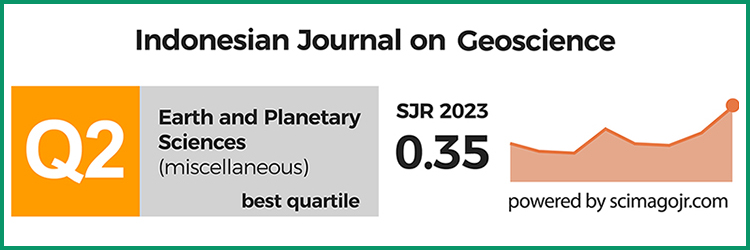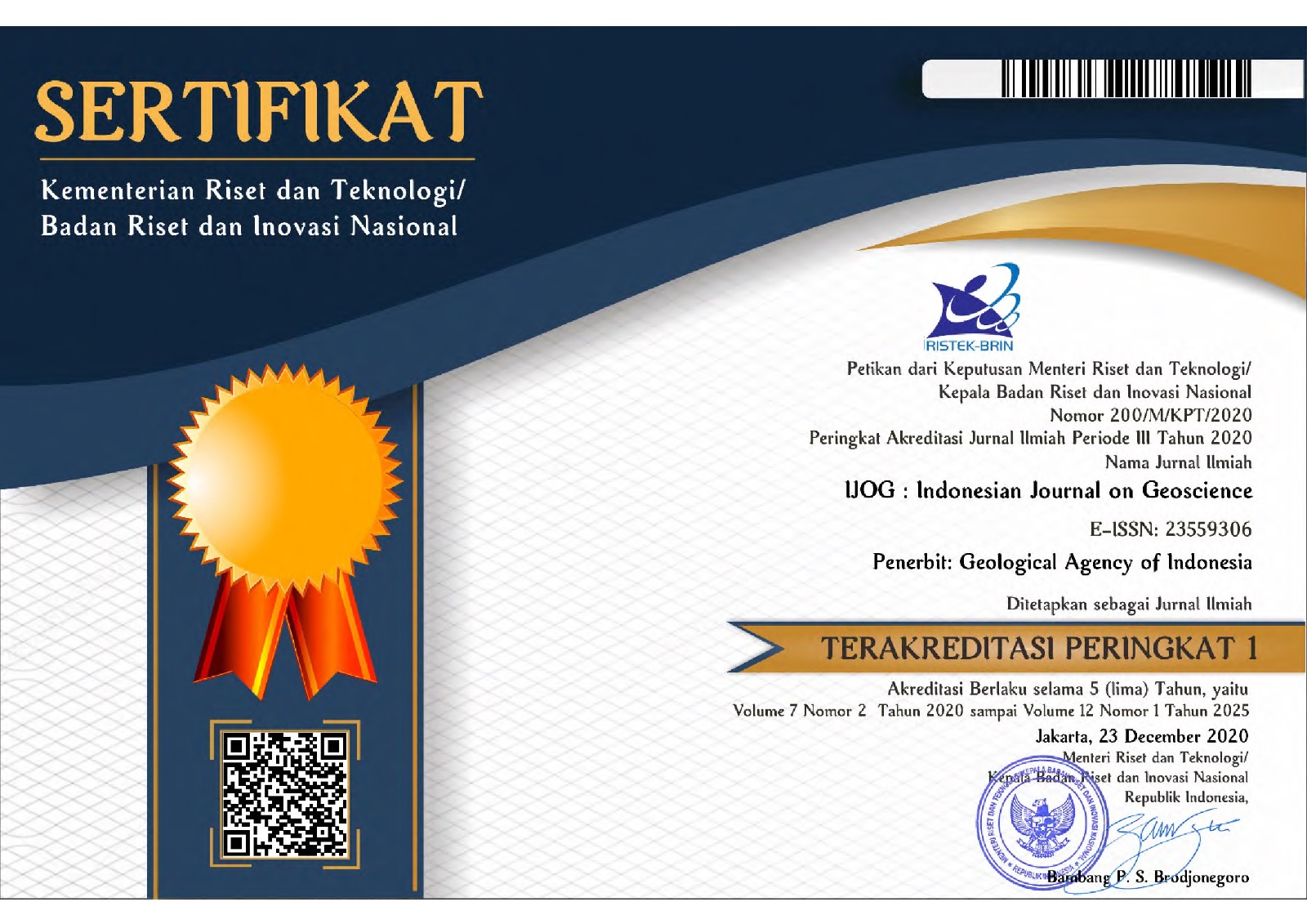Characteristics and Origin of Sedimentary-Related Manganese Layers in Timor Island, Indonesia
DOI:
https://doi.org/10.17014/ijog.8.4.191-203Keywords:
manganese nodule, manganese layer, Bobonaro, Timor Island, IndonesiaAbstract
Sedimentary-related manganese layers have been discovered in South Central Timor Regency, Timor Island, Indonesia, which is tectonically active and being uplifted due to north-trending tectonic collision between Timor Island arc and Australian continental crust. The manganese layers of 2 to 10 cm-wide interbed with deep sea sedimentary rocks including reddish - reddish brown claystone, radiolarian chert, slate, marl as well as white and pinkish calcilutite of Nakfunu Formations. Stratigraphically, the rock formations are underlain by Bobonaro Formation. Two types of manganese ores found comprise manganese layers and manganese nodule. The manganese layers strongly deformed, lenticular, and segmented, are composed of manganite [MnO(OH)], groutite [MnO(OH)], pyrolusite (MnO2), lithioporite (Al,Li) MnO2(OH)2, and hollandite [Ba (Mn4+, Mn2+)8O16] associated with gangue minerals including calcite, quartz, limonite [FeO(OH)], hematite (Fe2O3), and barite (BaSO4). Whilst the nodule type is only composed of manganite and less limonite. Geochemically, the manganese layers have grade of 63 - 72 wt.% MnO, whereas the nodule one has grade of 63 - 69 wt.% MnO. Generally, iron in Mn ore is very low ranging from 0.2 to 1.54 wt.% Fe2O3, averaged 0.76 wt.%. Hence, Fe/Mn ratio which is very low (0.003 - 0.069), typically indicates a sedimentary origin, which is also supported by petrologic and petrographic data showing layering structure of manganite and lithioporite crystal/grain. Trace element geochemistry indicates that manganese ore was precipitated in a reduction condition. Rare earth element (REE) analysis of manganese ore shows an enrichment of cerium (Ce) suggesting that the ore is basically originated in a marine environment. The manganese nodule is interpreted to be formed by chemical concretion process of unsoluble metals (i.e. mangan, iron) in seawater (hydrogenous) and precipitated on deep sea bottom. On the other hand, the manganese layer is a detrital diagenetic deposit formed by Mn remobilization in seawater column, precipitated and sedimented on the deep sea bottom. Manganese layers have probably been influenced by ‘hydrothermal process’ of mud-volcano activities, proven by the presence of quartz and barite veinlets cutting the Mn layers, manganite recrystallization to be pyrolusite along veinlets cutting manganite and lithioporite layers, and the presence of pyrite and sulphur associated with Mn layers. Field data also exhibit that the significant manganese layers are mostly found around mud volcanoes. The closely spatial and genetic relationships between manganese layers and mud-volcanoes might also be an important guide for the exploration of Mn deposit in the region.
References
Ati, E.M., 2012. Geologi dan karakteristik endapan mangan tipe sedimen di daerah Supul, Kab. Timor Tengah Selatan, Provinsi NTT. Thesis S2 (tidak dipublikasi), Program Studi Magister Geologi Pertambangan, Universitas Gadjah Mada, 197 pp.
Audley-Charles, M.G., Carter, D.J., and Barber, A.J., 1975. Stratigraphic basis for tectonic interpretation of the Banda arc, Eastern Indonesia. Proccedings of Indonesia Petroleum Association, 3rd Annual Convention, p.25-44.
Evans, A.M., 1993. Ore Geology and Industrial Minerals, Blackwell Publishing USA, 389pp.
Glasby, G.P., Keays, R.R., and Rankin, P.C., 1978. The Distribution of Rare Earth, Precious Metal and other trace elements in Recent and fossil deep sea manganese nodules. Geochemical Journal, 12, p.229-243. doi:10.2343/geochemj.12.229
Hamilton, W., 1979. Tectonics of the Indonesian Region: Geology Survey Professional Paper 1078, US Govt. Printing Office, Washington, 308pp.
Jiancheng, X., Xiaoyong, Y., Jianguo, D., and Wei, X., 2006. Geochemical characteristics of sedimentary manganese deposit of Guichi, Anhui Province, China. Journal of Rare Earths, 24, p.374-380. doi:10.1016/S1002-0721(06)60127-0
Krauskopf, K. B. and Bird, D. K.,1995. Introduction to Geochemistry. McGraw-Hill Book,New York, 721pp.
Mazzini, A., Svensen, H., Akhmanov, G.G., Aoisi, G., Planke S., Malthe, A., and Istadi, B. 2007. Triggering and dynamic evolution of the LUSI mud volcano, Indonesia. Earth and Planetary Science, 261, p.375-388. doi:10.1016/S1002-0721(06)60127-0
Maynard, J.B., 2005. Manganiferous Sediments, Rocks, and Ores. Treatise on Geochemistry, 7, p.289-424. doi:10.1016/B0-08-043751-6/07099-7
Nicholson, K., 1992. Contrasting Mineralogical and Geochemical signatures of Manganese Oxides: Guides to Metallogenesis. Economic Geology, 87, p.1253-1264. doi:10.2113/gsecongeo.87.5.1253
Rollinson, H., 1995. Using Geochemical Data. Longman Singapore Publishers (Pte) Ltd Singapore, 352pp.
Rosidi, H.M.D., Suwitodirdjo K., and Tjokrosapoetro S., 1979. Peta Geologi Lembar Kupang - Atambua, Timor. Pusat Penelitian dan Pengembangan Geologi, Bandung.
Tjia, H.D., 1979. Examples of young tectonism in Eastern Indonesia, in press.
Tjokrosapoetro, S., 1978. Holocene tectonics on Timor Island, Indonesia, Indonesia. Bulletin of Geological Survey, Indonesia, 4(1), p.49-63



















